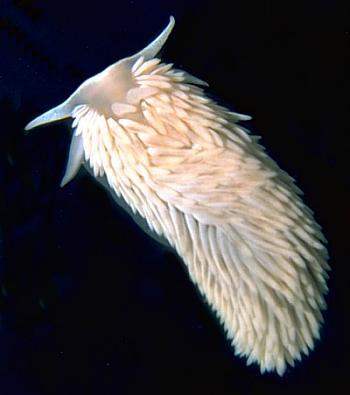
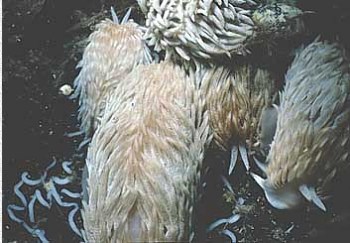
Aeolidiella drusilla
Bergh, 1900
Order: NOTASPIDEA
Suborder: AEOLIDINA
Family: Aeolidiidae
DISTRIBUTION
New Zealand, Tasmania, Victoria (south-eastern Australia)
PHOTO
Upper: Blackmans Bay, Hobart, Tasmania, Australia, October 1986. AM C151520. Photo: Bill Rudman.
Lower: Flinders Pier, Victoria, Australia, October, 1996. 10 specimens under a piece of timber on the bottom beneath the pier at 4m depth. Size range of 3 - 5cm Photo: John Chuk
RELATED TOPIC
Two species, Aeolidiella faustina and Aeolidiella drusilla, were first described from Cook Strait, New Zealand (Bergh, 1900). To my knowledge A. drusilla has never been reported again but A. faustina has been reported from northern Tasmania, Australia (Bergh, 1904) and Victoria, Australia where Burn (1962) recorded it as "very common under stones at or near low tide level". It has subsequently been reported as rare in the North Island of New Zealand (Powell, 1979). I have not seen a published photo of the living animal, although Powell publishes a colour painting from Auckland, NZ, of an animal he identifies as A. faustina which looks similar to the photo published here from Tasmania. As I discuss below there are apparent radula differences between the two species from New Zealand and Bergh's 'A. faustina' from Tasmania. The radular morphology of the animal photographed here from Tasmania is most similar to the original drawing of A. drusilla from New Zealand.
Note added 21 Nov. 2007: To indicate there was some doubt about the identity of Australian specimens they were previously labelled on the Forum as Aeolidiella cf. drusilla. However as discussed in a separate message [#21172] Miller (1971) described specimens of A. faustina and A. drusilla from New Zealand which clearly confirm that the Australian animal is A. drusilla despite earlier identifications as A. faustina.
-
Bergh, L.S.R. (1900) Ergebnisse einer Reise nach dem Pacific (Schauinsland 1896-1897). Die Opisthobranchier. 13(3), 207-246, Pls.19-21.
-
Bergh, L.S.R (1904) Malacologische Untersuchungen. In: C.G. Semper, Reisen im Archipel der Philippinen, Wissenschaftliche Resultate. Band 9. Lief 1.: 1-56,Pls.1-4.
-
Burn, R.F. (1962) Descriptions of Victorian nudibranchiate mollusca, with a comprehensive review of the Eolidacea. Memoirs of the National Museum of Victoria, 25: 95-128.
-
Miller, M. C. (2001) Aeolid nudibranchs (Gastropoda: Opisthobranchia) of the family Aeolidiidae from New Zealand waters. Journal of Natural History 35: 629-662.
-
Powell, A.W.B. (1979) New Zealand Mollusca. Marine Land and Freshwater Shells. Collins, Auckland. 500 pages.
Rudman, W.B., 2001 (February 4) Aeolidiella drusilla Bergh, 1900. [In] Sea Slug Forum. Australian Museum, Sydney. Available from http://www.seaslugforum.net/find/aeoldrus
Related messages
Re: Aeolidiella faustina or A. drusilla?
November 22, 2007
From: Bill Rudman
Concerning message #4159:
Ron Greer's message [# 21143] has caused me to return to my earlier comments on the identity of this animal, which had been identified by some Australian authors as A. faustina Bergh, 1900. In my earlier comments I said that the radula morphology of an animal from Tasmania best fitted A. drusilla rather than A. faustina, but that we needed to know something about the anatomy of animals from New Zealand, where both species were first described. By chance Michael Miller in the same year published descriptions of the anatomy of both species from New Zealand and the radula of his New Zealand specimens of A. drusilla match the Tasmanian animal perfectly. So I no longer need to call the Australian animals Aeolidiella cf drusilla and will change the name of the Fact Sheet accordingly.
I should also reiterate that Bergh's A. faustina from New Zealand is clearly a synonym of Spurilla macleayi which had earlier been described from Australia. Miller (2001) discusses the strong possiblity that the two species are the same.
-
Miller, M. C. (2001) Aeolid nudibranchs (Gastropoda: Opisthobranchia) of the family Aeolidiidae from New Zealand waters. Journal of Natural History 35: 629-662.
Bill Rudman
Rudman, W.B., 2007 (Nov 22) Re: Aeolidiella faustina or A. drusilla?. [Message in] Sea Slug Forum. Australian Museum, Sydney. Available from http://www.seaslugforum.net/find/21172Recent Sighting of Aeolidiella drusilla
November 22, 2007
From: Ron Greer
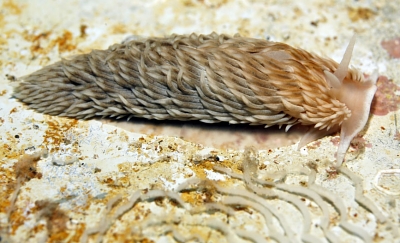
I recently dived Flinders Pier for the first time in many years and found a nudibranch I had not seen before. I believe it is Aeolidiella drusilla as identified from Neville Coleman's 1001 Nudibranchs. I also had a look in this site for more imformation and noted that they had not been seen for some years so I thought you may wish to know that there back. Perhaps they are only seen during egg laying and apparenly staying around the eggs for a period.
Locality: Flinders Pier, Western Port Bay, 5 m, Victoria, Australia, 09 September 2007, Mixed Sand and Mud.. Length: 40 mm. Photographer: Ron Greer.
There were many (12-15 seen) around, always under something in the dark and all were associated with eggs. They were also very light sensitive - even those on overturned rocks in the shade of the pier quickly headed for the edge of the rock and vitual darkeness.
The first 2 images were on sheet of broken building material, probably cement sheet, which would explain the nearly white background colour. The 3rd image was on a more natural background and shows a more direct association with the eggs.
Regards
Ron Greer
diveimage@netspace.net.au
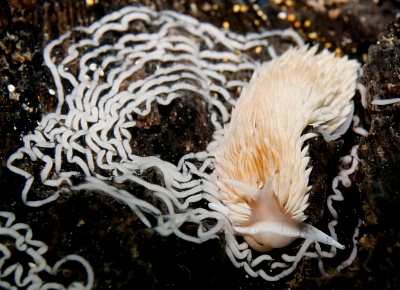
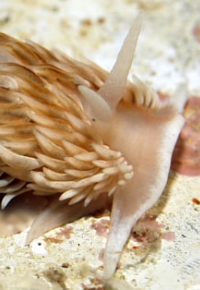
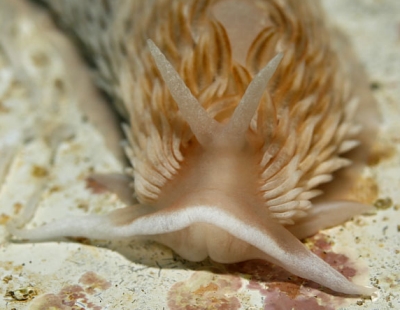
Dear Ron,
Thanks for the nice photos. They give me a chance to do a little house-keeping on the Forum and remove the 'cf' from Aeolidiella drusilla which I had added to the name as I had doubts about the real identity of Australian animals. However, since I wrote the Fact Sheet, Michael Miller published a paper on the New Zealand species of the family and his anatomical studies show that New Zealand specimens, on which the name is based, are identical to Australian animals.
I am not sure why this species is sometimes abundant and at other times very rare. One possibility is that the light sensitivity you mention indicates that it hides during the daytime and so is only found by diligent searching.
Best wishes,
Bill Rudman
How did Aeolidiella drusilla get its name
May 31, 2002
From: Drusilla
Dear Dr. Rudman,
Do you have any idea how the lovely Aeolidiella drusilla got her name?
Best Wishes,
Drusilla
DrusillaB@aol.com
Drusilla, 2002 (May 31) How did Aeolidiella drusilla get its name. [Message in] Sea Slug Forum. Australian Museum, Sydney. Available from http://www.seaslugforum.net/find/7095Dear Drusilla,
Obviously you have a personal interest in asking your question. Unfortunately many earlier scientists gave species their names without telling us why. Rudolph Bergh's description of this species is a case in point. Often species were named after classical Greek and Roman gods and goddesses and historical figures. At a guess this species was probably named after the influential wife of the Roman Emperor Augustus - Livia Drusilla.
Cheers,
Bill Rudman
Aeolidiella faustina or A. drusilla?
April 14, 2001
From: Glenys Greenwood
Dear Bill,
I was interested in John Chuk's description of nudibranchs he found under Flinders Pier [Victoria, Australia] in 1996. I too, noticed these same nudibranchs at Flinders Pier in what seemed to be large numbers during the summer of 1996-97 and had not seen them there previously. A stone turned over could reveal up to a dozen specimens including egg ribbons. I sent a specimen to Bob Burn for identification and he identified it as Aeolidiella drusilla. I discussed it with him again, after reading John's note to you and he confirmed that the radula of the specimen I sent him, was definitely A. drusilla - shaped, rather than the faustina shape. Interestingly, I found the odd specmen at Flinders pier over the next year, but haven't seen one since. My only other record of A. drusilla is off the reef at Flinders back beach about 12 years ago.
So perhaps John's nudibranch was A. drusilla???
Regards,
Glenys Greenwood
gegreeny@netspace.net.au
Greenwood, G., 2001 (Apr 14) Aeolidiella faustina or A. drusilla?. [Message in] Sea Slug Forum. Australian Museum, Sydney. Available from http://www.seaslugforum.net/find/4159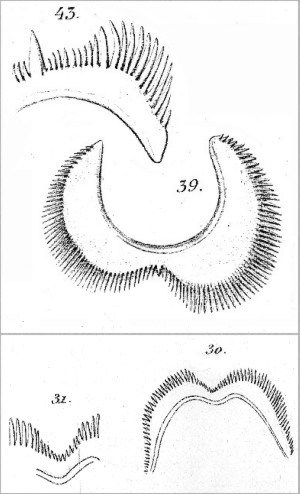
Dear Glenys,
Thanks for your comments. Both A. faustina and A. drusilla were described from single preserved specimens collected at Cook Sreait, New Zealand (Bergh, 1900). Since then, Bergh (1904) reported A. faustina from northern Tasmania and Bob Burn (1962) has reported it as very common under stones from a number of sites in Victoria. As far as I know, there is no record of A. drusilla being found since the original descritption. On this basis I was happy to follow Bergh and Burn in identifying the Bass Strait Aeolidiella as A. faustina. I realised there were differences in radular morphology but sometimes inaccuracies do occur in drawings of radular teeth.
I have copied the relevant radula drawings from Bergh alongside.
UPPER RIGHT: Drawings from Bergh, 1900: Fig 39 - Aeolidiella faustina; Fig 43 - Aeolidiella drusilla. Radula from holotypes collected in Cook Strait, New Zealand.
LOWER RIGHT: Bergh, 1904, Pl. 1. Figs 30,31. Radula of specimen identified by Bergh as A. faustina, from Ulverstone, nthn Tasmania. [mislabelled on plate captions as Aeolidiella pacifica.]
If we accept these drawings as accurate, then it looks unlikely that Bergh's Tasmanian specimen (Fig. 30-1) is the same as the New Zealand A. faustina (Fig 39). One other complication is that we have no information on the colour and shape of the living animals. Compare these drawings with SEM radula photos I have just posted of the animal from Tasmania.
So where does that leave us? The SEM photos of the Tasmanian specimen certainly looks most like Bergh's A. drusilla (Fig 43). What we really need to know is something about the New Zealand species. Powell (1979) publishes a colour painting of an animal from Auckland, NZ which looks very similar to the Tasmanian photo, but Powell, on the advice of Michael C. Miller identifies it as A. faustina. In Powell's monograph, Aeolidiella drusilla is not listed as part of the NZ fauna but no reasons are given for this omission.
On the strength of the shape of the radula teeth I guess this animal is most likely to be A. drusilla which would suggest that Bergh's and Burn's records of A. faustina from southern Australia are incorrect, as is Powell's from Auckland. I'll change the name on the Forum page to Aeolidiella cf. drusilla but I suspect this will not be the last word we hear on the topic.
References:
• Bergh, L.S.R. (1900) Ergebnisse einer Reise nach dem Pacific (Schauinsland 1896-1897). Die Opisthobranchier. . 13(3), 207-246, Pls.19-21.
• Bergh, L.S.R (1904) Malacologische Untersuchungen. In: C.G. Semper, Reisen im Archipel der Philippinen, Wissenschaftliche Resultate. Band 9. Lief 1.: 1-56,Pls.1-4.
• Burn, R.F. (1962) Descriptions of Victorian nudibranchiate mollusca, with a comprehensive review of the Eolidacea. Memoirs of the National Museum of Victoria, 25: 95-128.
• Powell, A.W.B. (1979) New Zealand Mollusca. Marine Land and Freshwater Shells. Collins, Auckland. 500 pages.
Best wishes
Bill Rudman
Aeolid from Victoria, Australia
February 6, 2001
From: John Chuk

Dear Bill,
I'm sending pictures of a nudibranch I photographed at Flinders Pier, Victoria, Australia on 7/10/96.
I found about ten specimens under a piece of timber on the bottom beneath the pier at 4m depth. They ranged between 3 & 5cm in length. There were masses of egg cord present. These were cylindrical in cross section with a tendency to be laid in a sausage-like pattern. Some of these cords were spirally laid (as one of the photo's shows) but many were laid in an irregular mass. It appeared to be a mass spawning event.
When I placed a specimen on the sand bottom to take a photo it promptly buried itself in the sand! I am unable to identify the species and any help would be most appreciated!
John Chuk
jchuk&giant.net.au


Dear John,
This is another interesting find. It is Aeolidiella faustina. First described from Cook Strait, New Zealand (Bergh, 1900) and then from northern Tasmania, Australia (Bergh, 1904) it was not reported again until Burn (1962) recorded it from Victoria as "very common under stones at or near low tide level". It has subsequently been reported as rare in the North Island of New Zealand (Powell, 1979). I have not seen a published photo of the living animal. It does not seem to get as far north as New South Wales.
Your observation of it burrowing in the sand is interesting, as in body shape it is certainly very similar to species of Cerberilla which is a related genus in which all the species are adapted to burrowing in sand. Thanks also for the photo of the egg ribbon.
Best wishes,
Bill Rudman
